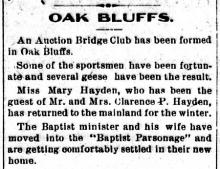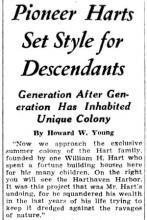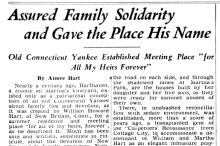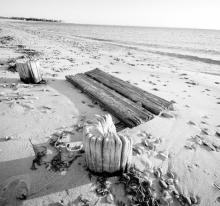“Now we approach the exclusive summer colony of the Hart family, founded by one William H. Hart who spent a fortune building houses here for his many children. On the right you will see the Harthaven Harbor. It was this project that was Mr. Hart’s undoing, for he squandered his wealth in the last years of his life trying to keep it dredged against the ravages of nature.”
So the spiel of the sightseers’ guide used to run as the Island-touring bus rolled along Edgartown road and into Oak Bluffs. It was good stuff for the Vineyard tourists. After all, they neither knew nor cared whether it was the truth.
Actually there was but one suggestion of the real facts in this interesting persiflage about Harthaven. That was that William H. Hart was highly instrumental in the founding of this community of about twenty summer homes, now landmarks along the beach road between Oak Bluffs and Edgartown.
That the community is exclusive is an oft-accepted misunderstanding; that William H. constructed the houses is only one-tenth fact, for he was personally responsible for only two of the cottages; that the harbor divested him of wealth is sheer fancy for the benefit of sightseers. But it all makes good listening for tired folks returning to Oak Bluffs on the last lap of an Island tour.
Five sons and one daughter, combining to form their own real estate concern under the name of the Hart Realty Company, banded together in a prospect to enable them to have neighboring cottages during vacations and to develop property for other off-Island families who desired to build summer places on the Vineyard.
As an incentive to his children in this venture, William H. Hart, president of the Stanley Works, a company manufacturing hardware in New Britain, Conn., laid the groundwork by arranging the purchase of considerable property between 1911 and 1913. This property he then deeded to the newly-formed realty company, and the houses started springing up.
Land was acquired from such well known Vineyard families as the Nortons, Charles T. Luce, Manuel S. DeBettencourt, Michael J. Keegan, the Beetles, the Sinclairs, and the Hamblins. The only stumbling block in the procedure proved to be a right of way across the beach, the beach that was used during the last century for the Oak Bluffs-Edgartown railway. Long after, the railroad had been abandoned, an Island man bought the right of way from the Oak Bluffs Land and Wharf Co., a privilege he was loathe to relinquish. Arguments and conferences eventually induced him to sell to William H. Hart, and all was set for building.
Designed Like Gramercy Park
The Hart brothers and sister negotiated with a landscape architect from Boston to design a plan of roadways and lots in the corner of land formed by First Inlet on the East and Farm Pond on the north. Cut through lush pine trees, this was to be an oval-shaped parkway similar to New York’s Gramercy Park in layout. Although the lots and roads through Martha’s Park, as it is now named, are still fashioned after this manner, the Harts themselves gave up the plan in favor of having their own homes nearer the beach.
First ground-breaking came with the building of William H. Hart’s white frame cottage at the east edge of the parkway and about 100 years west of the Edgartown road. This place is now owned by his daughter Martha, Mrs. E. A. Moore, and is still an outstanding feature of the Harthaven settlement. It was one of the few houses built for year-round occupancy, having plastered walls and central heating.
Next, the sons and daughter built in quick succession, Howard S. Hart, acquiring the high land directly north of the Martha’s Vineyard Country Club and erecting his stone home in 1914. Brothers Walter and Edward and sister Martha followed in rapid-fire order, all choosing property on the ocean side of the beach road. Maxwell Hart elected to build in the wooded area near his father’s place and completed his summer home shortly before the United States entered the first World War. Last to be finished was George Hart’s cottage across the Edgartown road from his father’s. William H. Hart built this house before his death, the second of the two he constructed at Harthaven, and his son purchased it through the Hart Realty Company several years afterwards.
During the war years private construction was discouraged, and it was not until the 20’s that more building was contracted. Grandsons and granddaughters of the Connecticut manufacturer set up their summer homes in Harthaven. In the latter part of the decade the first non-Hart families picked up property in the Martha’s Park section when the Joseph Hookers, Mrs. Harry Abbe, Mrs. Harry Boardman, and the William Coholans set down the foundations for their cottages on Farm Pond road.
A Much Discussed Title
By then the community was truly formed and was a real part of the Vineyard. It was Mrs. Martha Hart Moore who gave it its name of Harthaven, a title which has ever since been the cause for much discussion concerning its proper spelling.
Countless Harts have spent countless summers on the Vineyard. First came William H. and his wife Martha to whom can be attributed the discovery of the Vineyard for the Hart descendants. With several of their New Britain friends, they boarded a sailboat in New Bedford in the year 1857 and debarked at Gay Head. For four months the pioneers explored the Island, later to return again and again.
In 1871 William H. Hart bought a cottage on Penacook avenue, Cottage City, and the following year one on Pequot avenue, at a time when that settlement, later renamed Oak Bluffs, was scarcely more than a collection of Wesleyan tents and tabernacle. The young couple were entranced by the Vineyard and, despite the hardships of the long journeys to and from in those days continued to spend vacations with their entire family there. It became a standard procedure that William H. Hart’s birthday on July 25 could never properly be celebrated anywhere but at the Vineyard.
As their children matured, they too fell in love with the Island and wanted to establish themselves there as their father and mother had before them. George Hart, the eldest living son, first originated the idea of a Hart-haven. Driving along a narrow, sandy road out of Oak Bluffs with his friend, Wilber Rice of Schenectady, N. y., he eyed the property alongside Farm Pond and remarked on its beauty.
He told his father of his idea, that of acquiring a mass of adjoining land which would enable all the family to have homes close together. His father as well as his brothers and sister were in full support of such a project, which resulted in William H. Hart’s purchases and the subsequent formation of the Hart Realty Company.
Harts No Longer Predominate
Both William H. and Martha Hart, the pioneer Harts on the Vineyard, died many years ago; but their children, their grandchildren, the great grandchildren have been summering at Harthaven ever since. Property has been bought and sold over the years so that name of Harthaven no longer signifies any distinct predominance of Harts in the area. Families from New York and Virginia, from Connecticut and New Jersey are represented there.
Like the people, the land itself has altered considerably since Harthaven’s inception. The magnificent stone clubhouse of the Martha’s Vineyard Country Club was razed during the depression; and the harbor, once the mooring place for dozens of yachts and small boats, is now navigable only by rowboat or canoe.
To dredge an opening between Farm Pond and Vineyard Sound was a much discussed plan of the Hart family with opinions expressed on both sides and in the middle. The majority favored a harbor, and in 1916 work was first begun. With a sizable entrance, the harbor remained in good condition for three years before it required further maintenance. By the late 1920’s it was decided to abandon the initial opening, which had all but closed up completely, and dredge further north near the sea wall. Here large stone jetties were erected to hold back the filling action of the sea.
For several years thereafter the harbor once again contained a variety of craft, ranging from Howard Hart’s forty-foot yawl to Pete Hart’s flat-bottomed Spirit of Harthaven. But winter storms and autumn hurricanes were unkind to Harthaven Harbor, and again it filled with mud and sand.
Now, after the hurricane of 1944, the man-made entrance is piled high with sand from the ocean floor, but a new opening was cut by the force of the sea slightly farther south. No matter how man may try to shape the flow of the sea, as George Hart has said, “Nature settles these matters herself.”



 1 comment
1 comment





Comments (1)
Comments